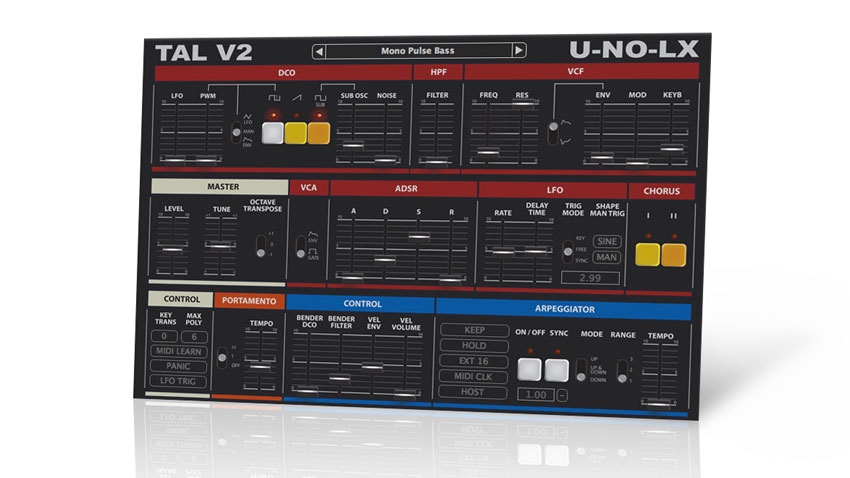MusicRadar Verdict
Justifying the price tag, TAL-U-NO-LX sounds right on the money - hopefully TAL addicts won't mind paying for it!
Pros
- +
Great-sounding filter. Authentic recreation of factory patches. Lots of sync options for the arpeggiator. TAL's new patch browser is good. Excellent chorus. Simple and to the point...
Cons
- -
...maybe too simple for more advanced synthesists
MusicRadar's got your back
There can't be many computer musicians who haven't benefited from the Togu Audio Line catalogue of plug-ins. Its list of freeware effects and synths is both long and impressive.
"These analogue-emulating plug-ins hold particular appeal to those of us still in love with the sharp, stinging sound of Roland's synths of the early 80s"
From TAL-Bassline to TAL-NoiseMaker, these analogue-emulating plug-ins hold particular appeal to those of us still in love with the sharp, stinging sound of Roland's (relatively) inexpensive synths of the early 80s.
Many TAL fans first realised the company's programming prowess via the TAL-U-NO-62, a lovingly realised clone of Roland's Juno-60, and a synth that in fact shares many features and design points with the instrument that we're looking at here.
TAL-U-NO-LX is a beefed up variation on TAL's excellent freebie. It's bigger, using up a lot more screen real estate and thus making it much easier to tweak, especially on the fly.
More importantly, though, the code has been reworked from the ground up and makes use of a zero-feedback delay filter design that makes this new version sound a lot more realistic.
The onboard controls have also been meticulously matched to those of the Juno-60. This is probably what facilitated the recreation of the original Roland's factory patch set, included along with a host of more original patches.
We've played a lot of Roland synths in our time and we have to say that TAL have nailed the retro sound of the patches. They ooze 80s cheese, with dopey brass and silly space effects sitting alongside those once-ubiquitous celesta and clav patches.
Want all the hottest music and gear news, reviews, deals, features and more, direct to your inbox? Sign up here.
Juno the score
For those not familiar with the Juno series, they offered a handful of voices (usually six, here 12) and a single oscillator per voice that produced a saw or pulse wave, each with its own level control for making more complex shapes.
A sub-oscillator could fatten things up with a square wave, and a high-pass filter comprising a single slider preceded a squelchy resonant low-pass filter. TAL has made its filter self-oscillating, and we certainly thank it for that.
"Not only is TAL-U-NO-LX a lot better than the free version, but the developer deserves our gratitude for years of inspiration and altruism"
A single ADSR envelope is shared by the filter and the amp, though you can switch the latter to gate mode, providing some disparity between the two sections. An LFO with the usual set of waveforms is onboard and syncable to the host tempo. That rich Roland chorus is also present in two flavours, as is an arpeggiator.
These are really the bare minimum functions for producing the simplest sounds. The Junos were never any good at deep, complex textures, but it was their simplicity that made them so appealing.
You could jump in, green as grass, and pull off distinctive tones that sat nicely in a mix. The sub-oscillator and chorus worked wonders to disguise the minimal parameters.
TAL-U-NO-LX stays quite faithful to the spirit of the original Juno series and the sound is very good indeed. It has that Roland snap and spike, belting out sounds to set your fillings rattling - you'd never know you were listening to a virtual analogue.
Is it worth 70 bucks? Absolutely, but TAL might have a hard time convincing users that they need buy it at all, what with TAL's free stuff being so good.
However, we reckon this is missing the point. Not only is TAL-U-NO-LX a lot better than the free version (in terms of sound quality and GUI, but also the addition of the arpeggiator, portamento and expanded control set), but the developer deserves our gratitude for years of inspiration and altruism.
Computer Music magazine is the world’s best selling publication dedicated solely to making great music with your Mac or PC computer. Each issue it brings its lucky readers the best in cutting-edge tutorials, need-to-know, expert software reviews and even all the tools you actually need to make great music today, courtesy of our legendary CM Plugin Suite.

